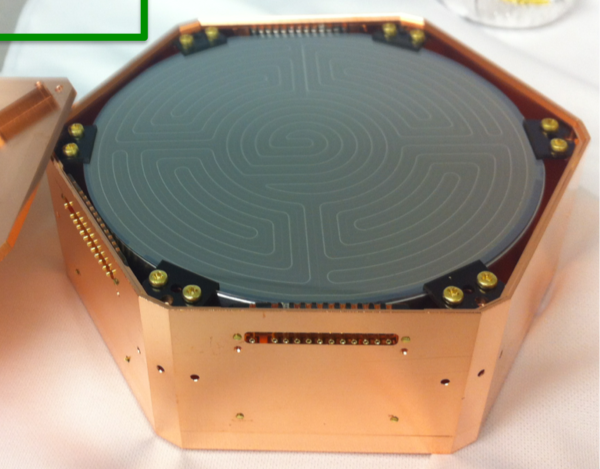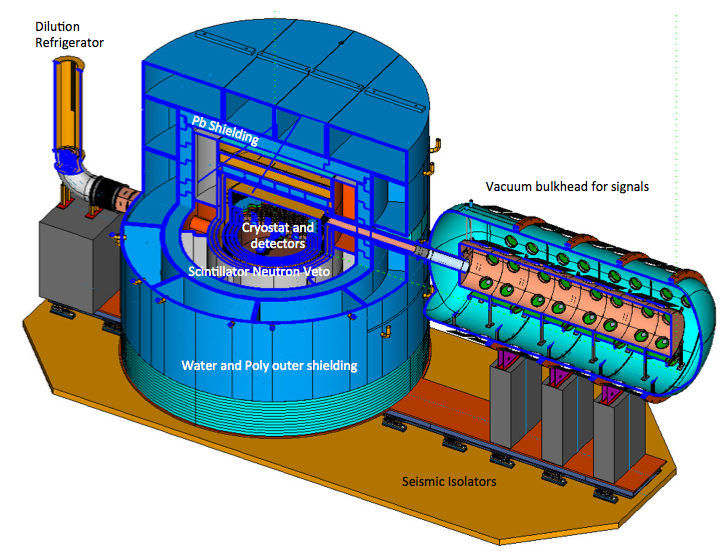Second generation dark matter experiment coming to SNOLAB

SNOLAB is pleased to welcome the SuperCDMS experiment to the underground science facility. The Super Cryogenic Dark Matter Search is an international, multimillion dollar dark matter experiment currently based in Minnesota with plans to progress the project by building a more sensitive detector at SNOLAB. This experiment has been selected by U.S. funding agencies as one of its major second-generation dark matter projects, receiving support for construction and operation at SNOLAB.
Utilizing state-of-the-art cryogenic germanium detectors, the SuperCDMS (SCDMS) collaboration is searching for dark matter particles, also known as weakly interacting massive particles (WIMPs). The discovery of these particles could resolve the dark matter problem, revolutionizing particle physics and cosmology. The use of underground facility at SNOLAB will provide shielding from cosmogenic events and as a result, reduce interference of known background particles. To search for dark matter, SCDMS scientists cool their detectors to very low temperatures in order to detect the very small energies deposited by the collisions of dark matter particles with the germanium.
Dr. Nigel Smith, SNOLAB Director, was delighted with the decision; “SNOLAB is really excited to hear the news that SuperCDMS-SNOLAB has been selected as one of the U.S. second generation direct dark matter search projects, and will be heading to SNOLAB for its next phase of operations. As a leading experiment in the field of dark matter searches, the combination of improved detector technologies and the facilities at SNOLAB will allow SuperCDMS to improve its sensitivity to WIMP dark matter interactions even further, and hopefully detect these elusive particles.
Attracting major international projects to our facilities in Sudbury has been one of the major objectives for SNOLAB since our inception, and so this decision by the US funding agencies is really great news. Researchers from around the world will be converging on Sudbury to build and operate this major project, including Canadian SuperCDMS collaborators at Queen’s University and University of British Columbia. We all look forward to welcoming the SuperCDMS collaboration to our facility, and helping them deliver new physics results from this exciting experiment.”
SCDMS-SNOLAB Collaboration spokesperson, Dr. Blas Cabrera, was happy with the announcement, “We are all very pleased with the selection of the SuperCDMS SNOLAB project in the second generation (G2) program to search for dark matter. We have been very pleased with the support that we have received within Canada from SNOLAB and from CFI (Canada Foundation for Innovation) and we look forward to a productive and exciting long partnership as we install and operate the experiment in the best underground laboratory in the world.”
In addition to its research accomplishments, SNOLAB has made a significant contribution to the Sudbury and provincial economy; to date, SNOLAB has generated almost $230 million in economic activity which translates into a benefit for Sudbury and Canada through jobs, attracting scientists and their families to the area as well utilizing local companies for custom manufacturing and fabricating requirements. The SCDMS-SNOLAB experiment will be a further boost to Sudbury and to the Canadian physics community.
SNOLAB is operated by the SNOLAB Institute whose member institutions are Carleton University, Laurentian University, Queen’s University, University of Alberta and Université de Montréal. It is located two kilometres below the surface in the Vale Creighton Mine near Sudbury, ON. Operational funding for SNOLAB is provided by the Canada Foundation for Innovation and the Province of Ontario.
SCDMS Experiment: http://cdms.berkeley.edu/index.html
Images: courtesy of SCDMS Collaboration
iZIP – Prototype iZIP detector for SuperCDMS SNOLAB
